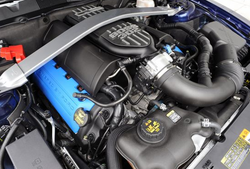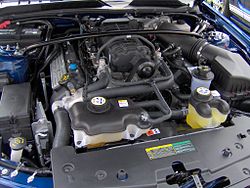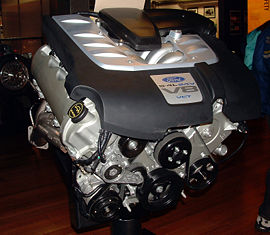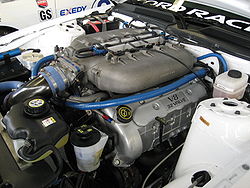- Ford Modular engine
-
Ford Modular engine 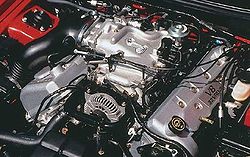
Manufacturer Ford Motor Company Also called Ford Triton
Lincoln InTech
Ford CoyoteProduction 1991–present Predecessor Ford Windsor V8
Ford 385 V8Displacement 281 CID (4601 cc)
302 CID (4951 cc)
305 CID (4992 cc)
323 CID (5284 cc)
330 CID (5408 cc)
413 CID (6760 cc)Cylinder bore 3.552 in (90.2 mm),
3.629 in (92.2 mm),
3.700 in (94 mm)Piston stroke 3.543 in (90 mm),
3.649 in (92.7 mm),
3.750 in (95.3 mm)
4.165 in (105.8 mm)Valvetrain OHC with Roller Finger Followers The Ford Modular engine is Ford Motor Company's overhead camshaft (OHC) V8 and V10 engine family, which has been produced in 4.6L, 5.0L (Cammer, Coyote), 5.4L, and 6.8L variations. Contrary to popular belief, the Modular engine did not get its name from its design or sharing of certain parts among the engine family. Instead, the name was derived from a manufacturing plant protocol, "Modular", where the plant and its tooling could be changed out in a matter of hours to manufacture different versions of the engine family.[1] The Modular engines are used in various Ford, Lincoln, and Mercury vehicles. Modular engines used in Ford trucks were marketed under the Triton name from 1997–2010 while the InTech name was used for a time at Lincoln for vehicles equipped with DOHC versions of the engines.
The engines were first produced in Romeo, Michigan but additional capacity was added in Windsor, Ontario.
Contents
4.6 L
The 4.6 L (4601 cc, 281 CID)[2] V8 has been offered in 2-valve SOHC, 3-valve SOHC, and 4-valve DOHC versions. The engines were also offered with both aluminum and cast iron blocks, depending on application. The 4.6 L's bore and stroke are nearly square at 90.2 mm (3.552 in) and 90 mm (3.543 in), respectively. Deck height for the 4.6 block is 227 mm (8.937 in) and connecting rod length is 150.7 mm (5.933 in) center to center, giving the 4.6 L a 1.67:1 rod to stroke ratio. Cylinder bore spacing measures 100 mm (3.937 in), which is common to all members of the Modular engine family. All Modular V8s, save for the new 5.0 L Coyote, utilize the same firing order as the Ford 5.0 L HO and 351 CID V8s (1-3-7-2-6-5-4-8). The 4.6 L engines have been assembled at Romeo Engine Plant, located in Romeo, MI, and at Windsor Engine Plant and Essex Engine Plant, both located in Windsor, Ontario.
2-valve
The first production Modular engine was the 4.6 L 2-valve SOHC V8 introduced in the 1991 Lincoln Town Car.
The 4.6 L 2V has been built at both Romeo Engine Plant and Windsor Engine Plant, and the plants have different designs for main bearings, heads (cam caps: interconnected cam "cages" vs individual caps per cam journal), camshaft gears (bolt-on vs. press-on), valve covers (11 bolts vs. 13 bolts), crankshaft (6 bolts vs. 8 bolts), and cross bolt fasteners for main bearing caps.
In 1999, the F-Series 5.4 L 2V and the Mustang 4.6 L 2V received upgrades which included cylinder heads with improved port and combustion chamber designs, a more aggressive cam profile, and improved intake manifolds. This upgrade was known as the PI (Performance Improved) package. In 2001, the F150 and Crown Victoria 4.6 Ls received the PI package. In keeping with traditional Ford practice, as engine design is revised over time and compatibility with previous versions is considered low priority,[3] so that parts from a Modular engine made in one model year are not necessarily likely to fit an engine made in another; and parts from an engine manufactured in Romeo are unlikely to fit an engine made in Windsor.[4]
Vehicles equipped with the 16-valve SOHC 4.6 L include the following:
- 1991–1993 Lincoln Town Car, 190 hp (142 kW) and 270 lb·ft (366 N·m)
- 1992–1997 Ford Crown Victoria/Mercury Grand Marquis, 210 hp (157 kW) and 270 lb·ft (366 N·m) with dual exhaust option
- 1998–2000 Ford Crown Victoria/Mercury Grand Marquis, 215 hp (160 kW) and 285 lb·ft (386 N·m) with dual exhaust option
- 2001–2002 Ford Crown Victoria/Mercury Grand Marquis, 235 hp (175 kW) and 275 lb·ft (373 N·m) with dual exhaust option
- 2003–2012 Ford Crown Victoria/Mercury Grand Marquis, 239 hp (178 kW) and 282 lb·ft (382 N·m) with dual exhaust option
- 2004–2011 Ford Crown Victoria Police Interceptor, 250 hp (186 kW) and 297 lb·ft (403 N·m)
- 1994–1997 Lincoln Town Car, 210 hp (157 kW)
- 1994–1995 Ford Thunderbird, 205 hp (153 kW) and 265 lb·ft (359 N·m)
- 1996–1997 Ford Thunderbird, 205 hp (153 kW) and 280 lb·ft (380 N·m)
- 1994–1995 Mercury Cougar, 205 hp (153 kW) and 265 lb·ft (359 N·m)
- 1996–1997 Mercury Cougar, 205 hp (153 kW) and 280 lb·ft (380 N·m)
- 1997–2010 Ford F-Series, 248 hp (185 kW) and 294 lb·ft (399 N·m) ratings for 2007 and later model year F-Series
- 1997–present Ford E-Series, 225 hp (168 kW) and 286 lb·ft (388 N·m) ratings for 2001 and later model year E-Series
- 1998–2000 Lincoln Town Car, 205 hp (153 kW)
- 2001–2002 Lincoln Town Car, 235 hp (175 kW)
- 2003–2011 Lincoln Town Car, 239 hp (178 kW)
- 2002–2005 Ford Explorer, 239 hp (178 kW) and 282 lb·ft (382 N·m)
- 1996–1997 Ford Mustang, 215 hp (160 kW) and 285 lb·ft (386 N·m)
- 1998 Ford Mustang, 225 hp (168 kW) and 290 lb·ft (393 N·m)
- 1999–2004 Ford Mustang, 260 hp (194 kW) and 302 lb·ft (409 N·m)
- 2003–2005 Rover 75, 260 hp (194 kW) and 302 lb·ft (409 N·m)
- 2003–2005 MG ZT, 260 hp (194 kW) and 302 lb·ft (409 N·m)
3-valve
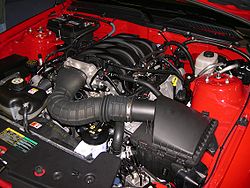 4.6 L 3-valve SOHC V8 installed in a 2006 Ford Mustang GT
4.6 L 3-valve SOHC V8 installed in a 2006 Ford Mustang GT
The 3-valve SOHC 4.6 L with variable camshaft timing (VCT) first appeared in the redesigned 2005 Ford Mustang.
The engines are equipped with an electronic Charge Motion Control Valve (CMCV) system that provides increased air velocity at low engine speeds for improved emissions and low-rpm torque. Cylinder block material varies between aluminum used in the 2005+ Mustang GT and cast iron used in the 2006+ Ford Explorer and the 2007+ Ford Explorer Sport Trac (see below), though the same aluminum heads are used in all applications.
The 3-valve SOHC 4.6 L engine was on the Ward's 10 Best Engines list for 2005–2008.
Vehicles equipped with the 24-valve SOHC VCT 4.6 L include the following:
- 2005–2009 Ford Mustang, 300 hp (224 kW) and 320 lb·ft (433 N·m)
- 2006–2010 Ford Explorer, 292 hp (218 kW) and 315 lb·ft (427 N·m)
- 2007–2010 Ford Explorer Sport Trac, 292 hp (218 kW) and 315 lb·ft (427 N·m)
- 2009–2010 Ford F-Series, 292 hp (218 kW) and 320 lb·ft (433 N·m)
- 2010 Ford Mustang, 315 hp (235 kW) and 325 lb·ft (440 N·m)
4-valve
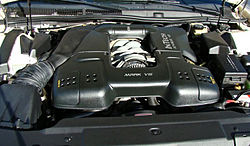 4.6 L 4-valve DOHC InTech V8 installed in a 1996 Lincoln Mark VIII
4.6 L 4-valve DOHC InTech V8 installed in a 1996 Lincoln Mark VIII
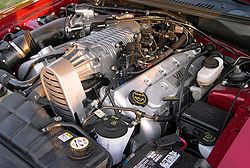 4.6 L 4-valve DOHC supercharged V8 installed in a 2003 Ford Mustang SVT Cobra
4.6 L 4-valve DOHC supercharged V8 installed in a 2003 Ford Mustang SVT Cobra
The 4-valve DOHC version of the Modular engine was introduced in the 1993 Lincoln Mark VIII as the 4.6 L Four-Cam V8. Lincoln marketed the engine under the name InTech after 1995.[5]
The 1993–1998 4-valve engines featured cylinder heads with two intake ports per cylinder (split-port) and variable runner length intake manifolds with either vacuum or electrically activated intake manifold runner controls (IMRC) depending on application. The engine was revised for 1999 with new cylinder heads featuring tumble-style intake ports (one intake port feeding two intake valves), new camshaft profiles, and fixed runner-length intake manifolds. These changes resulted in more power, torque and a broader power-band when compared to the earlier 4-valve engines.
All 4.6 L 4-valve engines featured aluminum engine blocks with 6-bolt main bearing caps, the only exception being the 2003–2004 SVT Cobra which had a 4-bolt main cast iron block. The 1999 and earlier engines featured an aluminum block cast in Italy by Fiat subsidiary Teksid S.p.A. Since 1996, all of the 4.6 L 4-valve engines manufactured for use in the SVT Cobra have been hand-built by SVT technicians at Ford's Romeo, Michigan plant.[6]
The 4-valve DOHC 4.6 L engine was on the Ward's 10 Best Engines list for 1996 and 1997.
Vehicles equipped with the 32-valve DOHC 4.6 L include the following:
- 1993–1998 Lincoln Mark VIII, 280 hp (209 kW) and 285 lb·ft (386 N·m)
- 1995–1998 Lincoln Continental, 260 hp (194 kW) and 265 lb·ft (359 N·m)
- 1996–1998 Ford Mustang SVT Cobra, 305 hp (227 kW) and 300 lb·ft (407 N·m)
- 1997–1999 Panoz AIV Roadster, 305 hp (227 kW) and 300 lb-ft (407 N-m)
- 1995–1998 Lincoln Mark VIII LSC, 290 hp (216 kW) and 295 lb·ft (400 N·m)
- 1997–1999 Marcos Mantis GT, 320 hp (239 kW) and 317 lb·ft (430 N·m)
- 1999–2002 Lincoln Continental, 275 hp (205 kW) and 275 lb·ft (373 N·m)
- 1999/2001 Ford Mustang SVT Cobra, 320 hp (239 kW) and 317 lb·ft (430 N·m)
- 2000–2001 Qvale Mangusta, 320 hp (239 kW) and 317 lb·ft (430 N·m)
- 2003–2005 MG X-Power SV, 320 hp (239 kW) and 317 lb·ft (430 N·m)
- 2000–2008 Panoz Esperante, 320 hp (239 kW) and 320 lb·ft (434 N·m) [7]
- 2003 Ford Mustang Mach 1, 305 hp (227 kW) and 320 lb·ft (434 N·m)
- 2004 Ford Mustang Mach 1, 310 hp (231 kW) and 335 lb·ft (454 N·m) [8]
- 2003–2004 Mercury Marauder, 302 hp (225 kW) and 318 lb·ft (431 N·m)
- 2003–2005 Lincoln Aviator, 302 hp (225 kW) and 318 lb·ft (431 N·m)
- 2003–2004 Ford Mustang SVT Cobra, Iron block, Supercharged, 390 hp (291 kW) and 390 lb·ft (529 N·m)
5.0 L Coyote
The 5.0 L (4951 cc, 302 cid)[9] "Coyote" V8 is the latest evolution of the Modular engine.[10] It shares the 4.6 L's 100 mm (3.937 in) bore spacing and 227 mm (8.937 in) deck height,[11] while bore diameter and stroke have increased to 92.2mm (3.629 in) and 92.7mm (3.649 in), respectively. The engine also retains the 4.6 L's 150.7 mm (5.933 in) connecting rod length, which produces a 1.62:1 rod to stroke ratio.[12] The firing order has been changed from that shared by all previous Modular V8s (1-3-7-2-6-5-4-8) to that of the Ford Flathead V8 (1-5-4-8-6-3-7-2).[12] Compression ratio is 11.0:1, and despite having typical port fuel injection (as opposed to direct injection) the engine can still be run on 87 octane gasoline.
The Coyote features a revised aluminum engine block with improved strength and crank-case ventilation, and all new 4V DOHC cylinder heads that have shifted the camshafts outboard, which allowed for a compact roller finger follower setup and improved (raised) intake port geometry. The result is an intake port that outflows the Ford GT intake port by 4 percent and the Yates D3 (NASCAR) intake port up to 0.472" (12 mm) lift, which is the maximum lift of the Coyote's intake cams.[12] The Boss 302 features versions of these cylinder heads with CNC ported intake/exhaust ports and combustion chambers, along with lightened valve-train components and lightweight sodium filled exhaust valves. The Coyote also features a forged crankshaft, powdered metal rods and hypereutectic pistons with oil jets to help piston cooling, while the Boss receives forged connecting rods, pistons and a deletion of the piston oil jets.[13] Engine redline is 7000 rpm for the GT and 7500 rpm for the Boss 302, though the Boss engine has been verified stable up to 8400 rpm. [14]
The engine is Ford's first V8 application of cam torque actuated (CTA) Twin Independent Variable Cam Timing (Ti-VCT), which allows the power-train control module (PCM) to advance and retard intake and exhaust cam timing independently of each other, providing improved power, fuel economy and reduced emissions. The engine also receives a new composite intake manifold with a single blade 80 mm (3.1 in) throttle mounted low and center, necessitating a relocation of the alternator to the side of the engine. The Boss 302 features a newer shorter-runner composite intake manifold, with the main plenum located above the intake runner entrances, to improve high-rpm horsepower. The engine is assembled in Ford's Essex Engine Plant in Windsor, Ontario, using existing Modular tooling.[15]
For the Australian Ford Falcon-based FPV GT range, the engine has been equipped with a Harrop/Eaton supercharger.[16][17]
The 4-valve DOHC Ti-VCT 5.0 L made Ward's 10 Best Engines list for 2011.[18]
Vehicles equipped with the 32-valve DOHC Ti-VCT 5.0 L include the following:
- 2011 Ford Mustang GT, 412 hp (307 kW) @ 6500 rpm, 390 lb·ft (529 N·m) @ 4250 rpm
- 2011 Ford F150, 360 hp (268 kW) @ 5500 rpm, 380 lb·ft (515 N·m) @ 4250 rpm [19]
- 2011 Ford Falcon GT,[20][21] Supercharged, 449 hp (335 kW) @ 5750 rpm, 420 lb·ft (569 N·m) @ 2200-5500 rpm[16]
- 2012 Ford Mustang Boss 302, 444 hp (331 kW) @ 7500 rpm, 380 lb·ft (515 N·m) @ 4500 rpm [13][22]
5.4 L
The 5.4 L (5408 cc, 330 CID)[2] V8 is a member of the Modular engine family first introduced in the redesigned 1997 Ford F-150 as a Triton V8. Bore diameter is 90.2 mm (3.552 in) and stroke is 105.8 mm (4.165 in), the increased stroke necessitated a taller 256 mm (10.079 in) engine block deck height. A 169.1 mm (6.658 in) connecting rod length is used to achieve a 1.60:1 rod to stroke ratio. The 5.4 L 2V was built at the Windsor Engine Plant, while the 5.4 L 3V moved production to the Essex Engine Plant beginning in 2003.[23] The SVT 5.4 L 4-valve engines are built at Romeo Engine Plant, hand assembled on the niche line.[24]
2-valve
Introduced in 1997, the SOHC 2-valve 5.4 L has a cast iron engine block and aluminum cylinder heads. The 5.4 L features multi-port fuel injection, roller finger followers, fracture-split powder metal connecting rods, and in some applications a forged steel crankshaft.
The 2-valve SOHC 5.4 L engine was on the Ward's 10 Best Engines list for 1997–1998 and 2000–2002.
Vehicles equipped with the 16-valve SOHC 5.4 L include the following:
- 1997–2004 Ford F-Series, 2-valve SOHC, 260 hp (194 kW) and 350 lb·ft (475 N·m) ratings for 1999 and later model years
- 1997–2004 Ford Expedition, 2-valve SOHC, 260 hp (194 kW) and 350 lb·ft (475 N·m) ratings for 1999 and later model years
- 1997–present Ford E-Series, 2-valve SOHC, 255 hp (190 kW) and 350 lb·ft (475 N·m) ratings for 1999 and later model years
- 1999–2004 Ford SVT Lightning, 2-valve SOHC, Supercharged, 380 hp (283 kW) and 450 lb·ft (610 N·m) ratings for 2001 and later model years
3-valve
In 2002, Ford introduced a new 3-valve SOHC cylinder head with variable camshaft timing (VCT), improving power and torque over the previous 2-valve SOHC version. The 3-valve cylinder head was first used on the 2002 Ford Fairmont 5.4 L Barra 220 engine in Australia.[25] The 3-valve 5.4 L was introduced to the North American market in the redesigned 2004 Ford F-150.
Vehicles equipped with the 24-valve SOHC VCT 5.4 L include the following:
- 2002–2005 Ford Fairmont, 3-valve SOHC, 295 hp (220 kW) and 347 lb·ft (470 N·m)
- 2003–2004 Ford Fairlane G220, 3-valve SOHC, 295 hp (220 kW) and 347 lb·ft (470 N·m)
- 2004–2008 Ford F-Series, 3-valve SOHC, 300 hp (224 kW) and 365 lb·ft (495 N·m)
- 2005–present Ford Expedition, 3-valve SOHC, 300 hp (224 kW) and 365 lb·ft (495 N·m) until Ford introduced a 10 horsepower gain, in 2010. Currently standing at 310 hp and 365 ft.-lbs of torque.
- 2005–present Lincoln Navigator, 3-valve SOHC, 300 hp (224 kW) and 365 lb·ft (495 N·m)
- 2005–2007 Ford Fairlane G8, 3-valve SOHC, 309 hp (230 kW) and 369 lb·ft (500 N·m)
- 2006–2007 Ford Fairmont, 3-valve SOHC, 309 hp (230 kW) and 369 lb·ft (500 N·m)
- 2009–2010 Ford F-Series, 3-valve SOHC, 320 hp (239 kW) and 390 lb·ft (529 N·m) ratings on e85 biofuel
4-valve
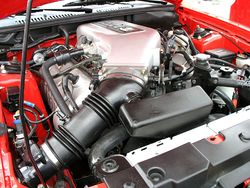 5.4 L 4-valve DOHC V8 installed in a 2000 Ford Mustang SVT Cobra R
5.4 L 4-valve DOHC V8 installed in a 2000 Ford Mustang SVT Cobra R
In 1999, Ford introduced the DOHC 4-valve 5.4 L in the Lincoln Navigator under the InTech moniker, making it the second engine to use this name. Ford later used versions of the DOHC 4-valve 5.4 L in the 2000 Ford Mustang SVT Cobra R, the Ford GT supercar, and the Ford Shelby GT500. The DOHC 4-valve 5.4 L was also used in the Ford Falcon line in Australia under the Boss moniker until 2010, when it was replaced by a locally-developed, supercharged version of the 5.0 litre Modular V8.
The SVT Cobra R version of the 5.4 L 4-valve V8 had several key differences from its Lincoln counterpart. While the iron block and forged steel crankshaft were sourced directly from the InTech 5.4 L, the Cobra R powerplant benefited from new, high-flow cylinder heads that were designed with features developed for Ford's "Rough Rider" off-road racing program, application specific camshafts with higher lift and more duration than other Modular cams, forged I-beam connecting rods sourced from Carillo, forged pistons that provided a 9.6:1 compression ratio in conjunction with the 52 cc combustion chambers, and a unique high-flow "cross-ram" style aluminum intake manifold. The Cobra R was rated at 385 hp (287 kW) and 385 lb·ft (522 N·m) though chassis dynamometer results have shown these ratings to be conservative with unmodified Cobra Rs often producing nearly 380 hp (280 kW) at the rear wheels. [26]
The Ford GT version of the 5.4 L is a highly-specialized version of the Modular engine. It is an all-aluminum, dry-sump 5.4 L 4-valve DOHC with a Lysholm screw-type supercharger and showcases numerous technological features, such as dual fuel injectors per cylinder and oil squirters for the piston skirts, not found in other Ford Modular engines. The GT 5.4 L benefits from an improved version of the high-flow 2000 Cobra R cylinder head and unique high-lift camshafts. The GT is rated at 550 hp (410 kW) and 500 ft·lbf (678 N·m).
The Shelby GT500 uses a 4-valve DOHC 5.4 L with an Eaton M122H Roots type supercharger and air-to-liquid intercooler.[27] The GT500 5.4 L shares its high-flow cylinder head castings with the Ford GT, with only minor machining differences, and shares camshafts with the 2003–2004 Ford Mustang SVT Cobra; which have less lift and duration than the Ford GT camshafts. The 2007–2010 GT500 engine used an iron engine block, while the 2011 GT500 5.4 L receives a new aluminum engine block, with Ford's first production application of their patented Plasma Transferred Wire Arc (PTWA) cylinder coating, eliminating the need for pressed in cylinder liners. The PTWA spray apparatus was co-developed by Ford and Flame-Spray Industries of Long Island, New York, for which they received the 2009 IPO National Inventors of the Year Award.[28] The 2011 GT500 engine weighs 102 lb (46 kg). less than the previous iron-block version, thanks in part to the lack of cast iron cylinder liners.[29] All of the 5.4 L 4-valve engines destined for use in SVT vehicles, such as the Ford GT and Shelby GT500, have been hand-built by technicians at Ford's Romeo, Michigan plant.[6]
Vehicles equipped with the 32-valve DOHC 5.4 L include the following:
- 1999–2004 Lincoln Navigator, 4-valve DOHC, 300 hp (224 kW) and 355 lb·ft (481 N·m)
- 2000 Ford Mustang SVT Cobra R, 4-valve DOHC, 385 hp (287 kW) and 385 lb·ft (522 N·m)
- 2002–2005 Ford Falcon XR8, 4-valve DOHC, 349 hp (260 kW) and 369 lb·ft (500 N·m)
- 2003 Ford Falcon FPV GT, 4-valve DOHC, 389 hp (290 kW) and 384 lb·ft (521 N·m)
- 2005–2006 Ford GT, 4-valve DOHC, Aluminum block, Supercharged, 550 hp (410 kW) and 500 lb·ft (678 N·m)
- 2007–2009 Ford Shelby GT500, 4-valve DOHC, Supercharged, 500 hp (373 kW) and 480 lb·ft (651 N·m) SAE J1349 certified
- 2007 Ford Falcon FPV GT Cobra, 4-valve DOHC, 405 hp (302 kW) and 398 lb·ft (540 N·m)
- 2008 Ford Falcon FPV GT, 4-valve DOHC, 422 hp (315 kW) and 406.5 lb·ft (551 N·m)
- 2010 Ford Shelby GT500, 4-valve DOHC, Supercharged, 540 hp (403 kW) and 510 lb·ft (691 N·m)
- 2011-2012 Ford Shelby GT500, 4-valve DOHC, Aluminum block, Supercharged, 550 hp (410 kW) and 510 lb·ft (691 N·m)
5.8 L
The 5.8 L (4601 cc, 351 CID) V8 will make a debut in the 2013 GT500. It is a 4-valve DOHC design with an aluminum block. The 5.8 L's bore and stroke are 3.75 in and 4.16 in, respectively. Boost will be supplied by a 2.3L TVS supercharger. [30] [31]
6.8 L V10
The 6.8 L (6760 cc, 413 CID) V10 is another variation of the Modular family created for use in large trucks. Bore size is 90.2 mm (3.552 in) and stroke is 105.8 mm (4.165 in), identical to the 5.4 L V8. Both 2-valve and 3-valve versions are currently produced. The 6.8 L uses a split-pin crank with 72° firing intervals and a balance shaft to quell vibrations inherent to a 90° bank angle V10 engine. The engine's firing order is 1-6-5-10-2-7-3-8-4-9. The 2-valve version was first introduced in 1997, with a 3-valve non-VCT version to follow in 2005. The 3-valve engine is built alongside the 2-valve engine at Ford's Windsor, Ontario LVL engine line.
Vehicles equipped with the 6.8 L V10 Modular engine include the following:
2-valve
- 1997–present Ford E-Series, 2-valve SOHC, 305 hp (227 kW) and 420 lb·ft (569 N·m) ratings for 2000 and later model years
- 1999–2004 Ford F-Series Super Duty, 2-valve SOHC, 310 hp (231 kW) and 425 lb·ft (576 N·m) ratings for 2000 and later model years
- 2000–2005 Ford Excursion, 2-valve SOHC, 310 hp (231 kW) and 425 lb·ft (576 N·m)
3-valve
- 2005–present Ford F-Series Super Duty, 3-valve SOHC, 362 hp (270 kW) and 457 lb·ft (620 N·m). 2011 MY only available for F-450 & F-550 as a Chassis cab.
- 2012 Ford F-650 & Ford F-750, 3-valve SOHC, 362 hp (270 kW) and 457 lb·ft (620 N·m).[33]
Ford of Australia
Ford Australia used 5.4 L Modular V8s in the Ford Falcon and previously on the Ford Fairlane sedan model ranges, as well as in its high performance Ford Performance Vehicles (FPV) division models, until mid2010, when they were replaced by the new 5.0 litre. The DOHC 5.4 L V8s are coined Boss by Ford Australia while the SOHC versions with VCT were coined Barra, with a number designation referring to power output in kW. The 3V SOHC Barra engines were, and the 4V DOHC Boss short blocks and cylinder heads are built in Windsor, Ontario. The Boss engines include some locally sourced parts such as intake and pistons. All are built with cast-iron blocks.
Ford of Australia 5.4 L engines include:
- Barra 220 3-valve SOHC 5.4 L V8, 295 hp (220 kW) @ 4750 rpm, 348 lb·ft (472 N·m) @ 3250-4000 rpm
- Barra 230 3-valve SOHC 5.4 L V8, 309 hp (230 kW) @ 5350 rpm, 369 lb·ft (500 N·m) @ 3500 rpm
- Boss 260 4-valve DOHC 5.4 L V8, 349 hp (260 kW) @ 5250 rpm, 369 lb·ft (500 N·m) @ 4000 rpm
- Boss 290 4-valve DOHC 5.4 L V8, 389 hp (290 kW) @ 5500 rpm, 384 lb·ft (521 N·m) @ 4500 rpm
- Boss 302 4-valve DOHC 5.4 L V8, 405 hp (302 kW) @ 6000 rpm, 398 lb·ft (540 N·m) @ 4750 rpm
- Boss 302 4-valve DOHC 5.4 L V8, 405 hp (302 kW) @ 6000 rpm, 406.5 lb·ft (551 N·m) @ 4750 rpm for the FPV GS model
- Boss 315 4-valve DOHC 5.4 L V8, 422 hp (315 kW) @ 6500 rpm, 406.5 lb·ft (551 N·m) @ 4750 rpm
5.0 L and 5.3 L Cammer
In 2005, Ford Racing Performance Parts introduced a 5.0 L (4992 cc, 305 CID) V8 crate engine for use in motor racing and home-made performance cars, officially called M-6007-T50EA, but more widely known as "Cammer". Since then, other higher performance variations of the Cammer have been introduced for KONI Sports Car Challenge and GT4 European Cup. All versions of the Cammer are DOHC 4-valve per cylinder designs with a 94 mm (3.700 in) bore and a 90 mm (3.543 in) stroke. The Cammer achieves its larger 94 mm (3.7 in) bore by resleeving a production 4.6 L aluminum block.
The T50 Cammer crate engine, the least expensive and most street oriented version, uses derivatives of the cylinder heads, variable runner-length magnesium intake manifold, and camshafts first used in the 2000 FR500 Mustang concept car. These parts are unique to the T50 Cammer crate engine and are not found in any other production Modular applications. The T50 has an 11.0:1 compression ratio and exceeds 415 horsepower (309 kW) with the proper exhaust manifolds.
The Cammer that has seen success in Grand Am Cup powering the Mustang FR500C is officially called M-6007-R50 and features a unique dual plenum, fixed runner-length magnesium intake manifold, Ford GT aluminum cylinder heads, unique camshafts of undisclosed specifications, and an 11.0:1 compression ratio. The R50 Cammer produces over 450 hp (336 kW) without restrictor plates. Upon introduction the R50 Cammer-powered Mustang FR500C proved to be dominant in Grand-Am Cup, having achieved five victories and podium appearances in nearly every race in the GS class during the 2005 season, giving David Empringham the championship title with the Multimatic Motorsports team, and Ford the manufacturer's title.
Robert Yates publicly expressed interest in using a similar 5.0 L 4-valve DOHC Modular V8 to compete in the NASCAR Winston Cup Series (now Sprint Cup Series).[34][35][36] Roush-Yates supplies a naturally aspirated [37] 550 hp (410 kW) 5.0 L Cammer for use in the Mustang FR500GT3 and Matech-Ford GT3 which participate in the FIA GT3 European Championship,[38][39] and a naturally aspirated 665 hp (496 kW) 5.3L Cammer for use in the 2010 Matech-Ford GT1 that competes in FIA GT1 World Championship.[40] The 5.3L Cammer's extra displacement is achieved via a 95.3 mm (3.750 in) stroke.
World record
The Koenigsegg CCR used a modified, Rotrex supercharged Ford Modular 4-valve DOHC 4.7L V8, which produced 806 hp (601 kW), to achieve a top speed of 241 mph (388 km/h). This certified top speed was recorded on February 28, 2005 in Nardo, Italy and broke the McLaren F1's world record for fastest production car.[41] The accomplishment was recognized by Guinness World Records in 2005, who gave the Koenigsegg CCR the official title of World's Fastest Production Car. The Koenigsegg record was broken several months later by the Bugatti Veyron. This engine is the basis for Koenigsegg's twin-supercharged flexible fuel V8 seen in the CCX.
Intake manifold defect
Starting in 1996, Ford began installing a DuPont Zytel nylon-composite intake manifold onto the 2-valve SOHC engines. Plaintiffs in class action lawsuits alleged that the coolant crossover passage of these intake manifolds may crack, resulting in coolant leakage. A US class-action suit was filed on behalf of owners, resulting in a settlement announced on December 17, 2005.
Starting with the 2002 model year, and implemented halfway through the 2001 lineup, Ford began using a revised DuPont Zytel nylon-composite intake manifold with an aluminum front coolant crossover that corrected the issue. Replacement intakes were also made available for 1996–2001 engines.[42] To be eligible for reimbursement, owners needed to contact a Ford, Lincoln or Mercury dealer within 90 days of December 16, 2005. Further, Ford offered an extended warranty for this part, for seven years from the start date (which means the initial vehicle sale date) without a mileage limitation.
The following vehicles were included in this class-action suit settlement:
- Mercury Grand Marquis, 1996–2001
- Lincoln Town Car, 1996–2001
- Ford Crown Victoria, 1996–2001
- Mercury Cougar, 1996–1997
- Ford Thunderbird, 1996–1997
- Ford Mustang, June 24, 1997–2001 (some vehicles)
- Ford Explorer, early 2002
Spark plug issues
2-valve 4.6 L, 5.4 L, and 6.8 L engines found in many 1997–2008 Ford, Lincoln, and Mercury vehicles have an issue with stripped or missing spark plug threads in the cylinder heads. Ford acknowledges this issue in TSB 07-21-2 as well as earlier TSB's. Ford's TSB does not state that this issue is caused by owner neglect. Ford's only authorized repair procedure for out-of-warranty vehicles is to use the LOCK-N-STITCH aluminum insert and tool kit. For vehicles under the New Vehicle Limited Warranty, Ford will only cover the replacement of the entire cylinder head; however, the Ford recommended spark plug service interval extends beyond the duration of the New Vehicle Limited Warranty.[43]
3-valve 5.4 L and 6.8 L engines built before 10/9/07 and 3-valve 4.6 Ls built before 11/30/07 found in many 2004–2008 Ford, Lincoln, and Mercury vehicles have an issue with difficult to remove spark plugs which can cause part of the spark plug to become seized in the cylinder head. The source of the problem is a unique plug design that is made with a 2-piece shell, which often separates, leaving the lower portion of the spark plug stuck deep in the engine. Ford acknowledges this issue in TSB 08-7-6 as well as earlier TSB's. Ford's TSB does not state that this issue is caused by owner neglect. The TSB provides a special procedure for spark plug removal on these engines. For situations where the spark plug has broken in the head, Ford distributes multiple special tools for removing the seized portion of the plug. The multiple procedures required for the different cases/situations of plugs seized in these engines are explained in the TSB. This repair is covered for vehicles under warranty; however, the Ford recommended spark plug service interval extends beyond the duration of the New Vehicle Limited Warranty.[44]
Federal-Mogul, parent company of Champion Spark Plug, and Brisk Silver Racing have introduced a 1-piece machined shell 3-valve spark plugs that addresses the OEM 2-piece spark plug's separation issues.[45][46]
References
- ^ [1] "Ford readies its mod squad - 32-valve 4.6 L Modular V-8 engine to be introduced late this year in the Lincoln Mark VIII automobile".
- ^ a b "Ford Vehicles: Get Specifications F-150". Ford Motor Company. http://www.fordvehicles.com/trucks/f150/features/specs/. Retrieved 2008-04-25. "Engine type: 5.4L Triton SOHC 24-valve V8... Displacement (cu. in.): 330 CID"
- ^ High Performance Ford Engine Parts Interchange, George Reid, SA Publications, 56
- ^ Modular Motor Build Up - Part 2 - Engine Block Preparation, Nick Spinelli, ModularFords.com
- ^ Ford Motor Company. 1993 Lincoln Mark VIII, pages 5–6,18. 1993. MarkVIII.org. http://www.markviii.org/LOD2/1993brochure/FrameSet.htm
- ^ a b When Factory Automation Just Isn't Appropriate : Industrial Market Trends
- ^ "Panoz Auto Development Company". Panozauto.com. http://www.panozauto.com/EsperanteGTLMDetails.htm. Retrieved 2010-04-15.
- ^ http://www.mach1registry.com/images/2004mustangs.pdf
- ^ http://media.ford.com/images/10031/2011_Mustang_GT_Specs.pdf
- ^ "2011 Ford Mustang GT: First Look". Insideline.com. 2009-12-28. http://www.insideline.com/ford/mustang/2011/2011-ford-mustang-gt-5-0-first-look.html. Retrieved 2010-04-15.
- ^ "Mustang GT 5.0 Returns in 2011 After 10-Year Hiatus". Popularmechanics.com. http://www.popularmechanics.com/automotive/new_cars/4341482.html. Retrieved 2010-04-15.
- ^ a b c 5.0 Mustang & Super Fords (March 2010) "Coyote Beautiful"
- ^ a b http://media.fordvehicles.com/article_display.cfm?article_id=33066
- ^ http://slumz.boxden.com/f22/2012-ford-mustang-boss-302-a-1501698/
- ^ Abuelsamid, Sam (2009-12-28). "Deep Dive: Ford's all-new 5.0 V8 — Autoblog". Autoblog.com. http://www.autoblog.com/2009/12/28/deep-dive-fords-all-new-5-0-v8/#continued. Retrieved 2010-04-15.
- ^ a b "First drive: FPV GT - Ford’s updated Falcon GT". The Age. 2010-10-07. http://theage.drive.com.au/motor-news/first-drive-fpv-gt-20101005-165rc.html. Retrieved 2010-10-07.
- ^ http://www.fpv.com.au/the-new-boss-v8.aspx
- ^ http://wardsauto.com/ar/names_best_engines_101207/
- ^ http://media.ford.com/article_display.cfm?article_id=33096
- ^ "Ford’s new 5.0L ‘Coyote’ V8 confirmed for 2010… " Ford News Blog". Fordnewsblog.wordpress.com. 2009-05-19. http://fordnewsblog.wordpress.com/2009/05/19/fords-new-5-0l-coyote-v8-confirmed-for-2010/. Retrieved 2010-04-15.
- ^ Ford Performance Vehicles, (2 September 2010), News & Media: FPV announces supercharged V8 engine program
- ^ http://www.mustangevolution.com/201012024595/
- ^ "FORD'S EXPANDED WINDSOR OPERATIONS TO PRODUCE NEW TRITON V-8 ENGINE | Ford Motor Company Newsroom". Media.ford.com. 2002-11-05. http://media.ford.com/article_display.cfm?article_id=13635. Retrieved 2010-04-15.
- ^ Rigney, Matt (2009-02-19). "Ford's Romeo Engine Plant Builds 10 Millionth Engine". Mustang Blog. http://www.mustangblog.com/blog/1018726_fords-romeo-engine-plant-builds-10-millionth-engine. Retrieved 2010-04-15.
- ^ Ford's Power Trip
- ^ "2000 Dodge Viper vs. 2000 Ford Cobra R - Detroit Muscle 2000". Archived from the original on August 30, 2011. http://www.motortrend.com/roadtests/112_0008_2000_viper_cobra_r_and_corvette/lap_times.html/. Retrieved August 30, 2011.
- ^ "Ford Engines - Technical Focus - Winding Road - September 2006 :: Winding Road". Archived from the original on February 22, 2008. http://web.archive.org/web/20080222195547/http://www.windingroad.com/features-page/ford-engines/. Retrieved March 4, 2008.
- ^ "Energy-Efficient Engine Technology Wins Ford Team National Inventor ... - Press Release". Ford. http://www.ford.com/about-ford/news-announcements/press-releases/press-releases-detail/pr-energyefficient-engine-technology-30443. Retrieved 2010-04-15.
- ^ "2011 Ford Shelby GT500". Autos Fans. 2010-02-08. http://autosfans.com/2011-ford-shelby-gt500/. Retrieved 2010-04-15.
- ^ "The 2013 Shelby GT500 wants to make the Camaro ZL1 its bitch". Jalopnik. http://jalopnik.com/5859549/the-2013-shelby-gt500-wants-to-make-the-camaro-zl1-its-bitch. Retrieved 2011-11-19. "Engine type: 5.8L DOHC 32-valve V8... Displacement (cu. in.): 351 CID"
- ^ "2013 Shelby GT500 Introduction". http://www.blueovalforums.com/forums/index.php?/topic/48061-2013-shelby-gt500-introduction/. Retrieved 2011-11-19. "Engine type: 5.8L DOHC 32-valve V8... Displacement (cu. in.): 351 CID"
- ^ LINCOLN 4.6 TIMING
- ^ http://news.pickuptrucks.com/2010/07/ford-to-offer-v10-gas-engine-for-mediumduty-chassis-cab-trucks.html
- ^ [2] Robert Yates on Modulars in Winston Cup.
- ^ [3] Robert Yates saw the light.
- ^ [4] "While we know Robert Yates is personally interested in promoting the Modular engine for Winston Cup..."
- ^ "2007 Ford Mustang FR500GT - Road Test - Auto Reviews - Car and Driver". Mobilelink.caranddriver.com. http://mobilelink.caranddriver.com/reviews/car/06q4/2007_ford_mustang_fr500gt-road_test. Retrieved 2010-04-15.
- ^ News: Ford FR500GT Mustang To Go After European FIA Racing With Some Serious Man-Boy Action
- ^ "8563_ford GT3:GB" (PDF). http://www.matech-concepts.ch/img/construction/Specsheet-FGT3.pdf. Retrieved 2010-04-15.
- ^ http://www.matech-competition.ch/index.php?page=techspec&hl=en
- ^ Koenigsegg World Record Press Release
- ^ "Ford, plaintiffs finalize manifold suit settlement". Detroit News. http://www.detnews.com/apps/pbcs.dll/article?AID=/20051217/AUTO01/512170310/1148. Retrieved December 17, 2005.
- ^ https://www.fleet.ford.com/showroom/CVPI/pdfs/TSB072102SparkPlugThreads.pdf
- ^ Ford TSB 08-7-6
- ^ http://www.aftermarketnews.com/Item/25952/federalmoguls_champion_brand_introduces_new_one_piece_premium_replacement_spark_plug.aspx Ford 3-Valve Plug By Champion
- ^ http://www.briskracing.com/product.php?productid=57
See also
« Previous — Ford Motor Company engine timeline, North American market, 1980s–2010s Type 1980s 1990s 2000s 2010s 0 1 2 3 4 5 6 7 8 9 0 1 2 3 4 5 6 7 8 9 0 1 2 3 4 5 6 7 8 9 0 1 4-cylinder engines Lima/OHC I4 CVH I4 HSC I4 Zetec I4 Duratec 23/25 I4 Inline-6 engines Thriftpower Six I6 300/4.9 I6 V6 engines Cologne V6 Cologne V6 SOHC V6 Essex V6 Vulcan V6 SHO V6 Duratec V6 Cyclone/Duratec/EcoBoost V6 V8 engine SHO V8 Windsor V8 Modular/Triton/InTech/Coyote V8 335/Modified V8 385 V8 Boss V8 V10 engines Triton V10 Diesel engines IDI V8 PowerStroke V8 PowerStroke V8 PowerStroke V8 Scorpion V8 « Previous — Ford Motor Company engine timeline, North American market, 2010s–2030s Type 2010s 2020s 2030s 0 1 2 3 4 5 6 7 8 9 0 1 2 3 4 5 6 7 8 9 0 1 2 3 4 5 6 7 8 9 Over Head Cam(OHC) Modular V8 Boss V8 Categories:- Ford engines
- Goods manufactured in Canada
- Motor vehicles manufactured in the United States
Wikimedia Foundation. 2010.

